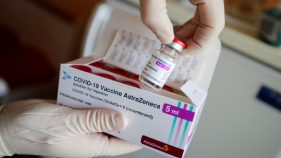By AFP

The United States was among the biggest backers of the AstraZeneca Covid vaccine, but a series of blunders by the company eroded American authorities’ confidence and have delayed rollout in the world’s hardest-hit country.
The British-Swedish drugmaker was on the backfoot Tuesday, vowing to release more data “within 48 hours” after the US National Institute of Allergy and Infectious Diseases (NIAID) raised concerns about results reported from a US trial.
AstraZeneca’s troubles in Europe, where several countries paused rollout over potential clotting risks are well documented — but its relationship with US health agencies has been fraught too.
One time favorite
Think back to last May, when then-president Donald Trump launched “Operation Warp Speed” to decide which vaccine makers to fund and order from, well before there was any inkling of results and even doubts about whether any would work.
The AstraZeneca vaccine, developed with Oxford University, was a leading contender because of its past work on a MERS vaccine, and the fact it was based on adenovirus vector technology — considered more “tried and true” than untested mRNA vaccines.
The US ordered 300 million doses, far more than its initial orders for Moderna and Pfizer (100 million each), and gave the company $1.2 billion.
Trial pause
The first sign of trouble came back in September when AstraZeneca paused its global trials after a British participant developed neurological symptoms.
Such pauses aren’t unusual — Johnson & Johnson also had to temporarily halt its trials — but according to reports, the US Food and Drug Administration only learned of the problem via the news, damaging trust.
While Britain quickly resumed its trial, the US waited about seven weeks to restart its clinical trial while it carried out its own investigations.
Lack of transparency
In November, AstraZeneca became the third company to announce promising early results — declaring its vaccine efficacy ranged from 62 percent to 90 percent, depending on dosing, and the average was 70 percent.
Scientists were left scratching their heads at the discrepancies, because a lower first dose seemed to work better.
AstraZeneca had also pooled results from differently designed trials in Britain and Brazil, which is considered irregular.
It later emerged that the different dosing regimes had occurred by accident, not design — something the company omitted to mention.
And it was left to Moncef Slaoui, then chief advisor to Warp Speed, to reveal in a call to US reporters that the group that achieved 90 percent efficacy did not include anyone aged over 55.
Latest ‘unforced error’
On Monday, AstraZeneca released its results from a trial carried in the US, Peru, and Chile that showed an efficacy of 79 percent at preventing symptomatic Covid, and 100 percent at preventing hospitalizations and death.
Then came the NIAID statement, which said an independent board charged with monitoring the trial “was concerned” that AstraZeneca “may have included outdated information from that trial,” skewing the figures.
The highly unusual move was “a curveball no one saw coming,” Natalie Dean, a biostatistician at the University of Florida, wrote on Twitter.
Experts interpreted it to mean the US wants AstraZeneca to update its analysis, which the company has since said it will do.
Anthony Fauci, who heads up NIAID, told “Good Morning America” that “the data really are quite good, but when they put it into the press release, it wasn’t completely accurate.”
“In my mind, it’s an unforced error by the company,” he added to medical news site Stat.
Does the US need AstraZeneca?
The US has authorized three vaccines — Pfizer, Moderna, and Johnson & Johnson — and between them they should be able to ship enough doses to cover more than the US adult population by the end of May.
AstraZeneca said it expected to apply for authorization “in the coming weeks” and a stamp of approval by the FDA — the gold standard regulator — would go far in assuaging global doubts over the vaccine.
On the other hand, some prominent experts now argue the US should ship its tens of millions of doses to low-income countries that are facing serious shortages.
In this article:
